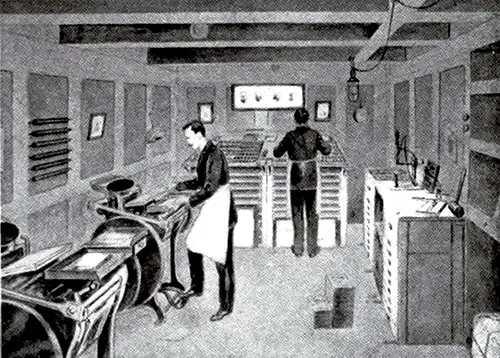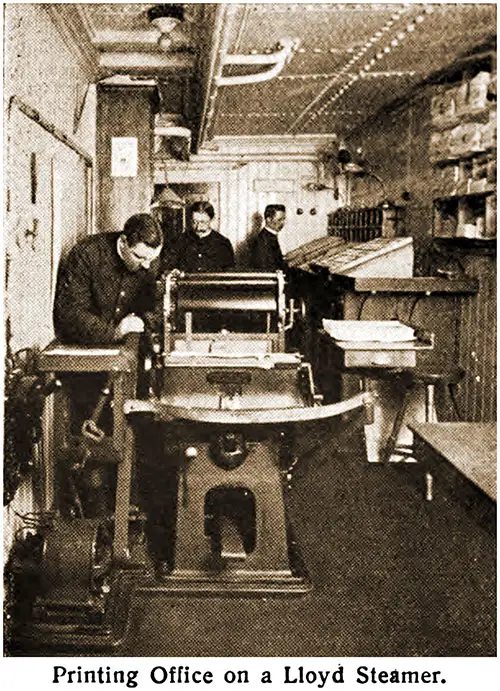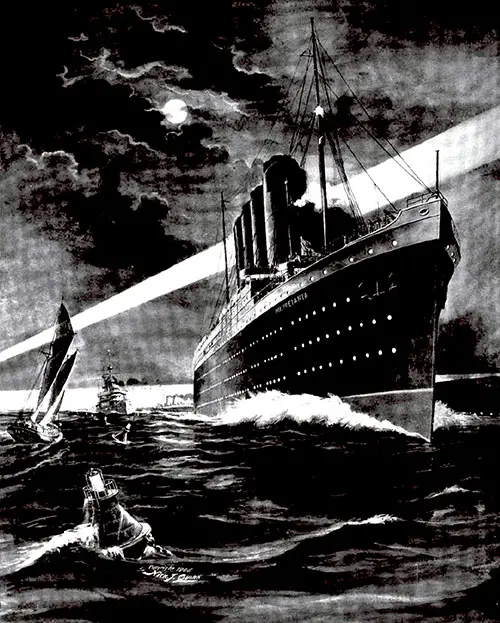The Print-Shop on the Sea - 1906

Printing Office of the Cunard Daily Bulletin on Board a Cunard Steamer. The Island Printer 1907-12 p. 389. | GGA Image ID # 12955d4139
The iconoclastic hammer of scientific progress has destroyed another ideal of the seeker for solitude who, until recently, could "flee from the madding crowd" and isolate himself from the doings of the world for a few days at Jest, far out on the bosom of the broad Atlantic, secure from the metallic tick of the stock tape, the political quarrels of nations, baseball news and the latest morsel of society scandal.
That one place for mental rest exists no longer, for it has been invaded by Marconi's wireless telegraph system so that an Atlantic liner is in constant touch with the market, the Associated Press and the world's affairs in general.
Even yellow journalism penetrates the traveler's retirement, and though lacking red, blue and "yellow" (sensational) headlines, it is none the less a chip of the old block so popular with the masses in our cities.
Here the broker no longer escapes the stock quotations, the fleeing banker the cry of pursuers or the prizefighter his mouth contests, for the "Wireless" transmits and receives everything that can be printed in a daily newspaper.

Printing Office on a North German Lloyd Steamer. Norddeutscher Lloyd History and Organization, 1908. | GGA Image ID # 1ddd12aa0f
While many warships publish papers at sea mainly relating to official duties, they are scarcely regarded as newspapers, and it remained for the Cunard Steamship Company to inaugurate the first daily newspaper ever printed on board ship.
The SS Etruria of this line, famous for the shuttlecock regularity of her voyages, which seldom vary more than three hours from her schedule, was chosen for the experiment, and a creditable though short account of passing events was printed in a little pamphlet of four pages called the Cunard Bulletin.
This service proved so popular that similar papers were established on other ships of that line, though much improved, and the paper was enlarged, until now the more famous ships of the Cunard Line publish a handsomely dressed newspaper of thirty-two pages containing the latest news, contemporary illustrations and an active line of advertising.
The title now reads Cunard Daily Bulletin, with subheads for "Marconigrams Direct to the Ship."
It seems so incredible to receive news at sea resolved from the wandering air and caught on a needlepoint, items of importance flashed from the stations at Poldhu in Cornwall or Siasconset, Nantucket, the ethereal waves carrying them picked up by the ships' operators, and their stories transposed for the editor in his floating sanctum.
The copy is then rapidly set by the "comps." and proof submitted to the editor. After correcting, it is run on two presses, folded and delivered to many passengers before they leave their berths.
Like other dailies ashore the Bulletin does not depend on daily happenings alone, for the average reader wants other matter in his paper than bald news; so the contents are varied by stories, articles on miscellaneous topics, puzzles and even poetry.
The Cunard Daily Bulletin is printed on fine coated paper, and a collection of the successive issues is valued as a souvenir of the trip.
When the new express steamers Lusitania and Mauretania are in commission next year their equipment of devices for safety, speed and news-gathering will be a revelation to the public, and remind one of Bellamy's dream of "Looking Backward."
The two ships will be the largest, fastest and most luxuriously furnished ever planned or realized, besides remarkable as being the most massive portable objects on the earth.
Their seventy thousand horsepower turbine engines will be a leading attraction for even laymen, as they are the largest ever constructed and will drive these 790-foot ships, each having four propellers, at the railroad rate of speed of thirty miles per hour.
To safely dock these ships, which will draw thirty-seven and one-half feet of water, the United States Government is dredging a new channel at New York which will be forty feet deep, two thousand feet wide and eight miles long.

Ambrose Channel At Night 1907 (A Print-Shop on the Sea) RMS Mauretania. From Painting by Nick J. Quirk © 1906. | GGA Image ID # 129568776f
It will be called the Ambrose Channel, and he the most brilliant waterway at night in the world. The red and white floating gas-buoys on each aide of the fairway, lightship, beacons and range lights will coat $320,000 to install and will form a lane of light spectacular in its impression to the vision of the stranger approaching the harbor at night.
Nick J. Quirk, "Floating Cities and Their News Service. The Print-Shop on the Sea." in The Island Printer, Vol 38, No. 3, December 1906, p. 389-390.
